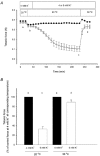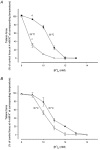Loss of force induced by high extracellular [K+] in rat muscle: effect of temperature, lactic acid and beta2-agonist
- PMID: 12813152
- PMCID: PMC2343135
- DOI: 10.1113/jphysiol.2003.041418
Loss of force induced by high extracellular [K+] in rat muscle: effect of temperature, lactic acid and beta2-agonist
Abstract
Loss of K+ from active muscles, leading to increased [K+]o, has been proposed to cause muscle fatigue by reducing excitability. Since exercise increases muscle temperature, we investigated the influence of temperature on muscle [K+]o sensitivity. Intact rat soleus or extensor digitorum longus (EDL) muscles were mounted on force transducers and stimulated electrically to evoke short isometric tetani at regular intervals. In each experiment, control force at 4 mM K+ was initially determined at every temperature used. In soleus muscles at 20 degrees C, 9 mM K+ reduced force to 33 +/- 5 % of control force. Increasing the temperature to 30 degrees C restored force to 89 +/- 5 % of control force. Likewise, at 30 degrees C 11 mM K+ reduced force to 16 +/- 4 % and increasing the temperature to 35 degrees C restored force to 35 +/- 5 %. Similar results were obtained using EDL. The force recovery induced by elevating temperature, reflecting reduced [K+]o sensitivity, was associated with improved excitability assessed from compound action potentials. Force recovery induced by a temperature elevation from 20 to 30 degrees C was associated with hyperpolarization (5 mV), reduced [Na+]i and a 93 % increase in Na+-K+ pump activity. The force recovery was blocked by ouabain. Since intensive exercise leads to lactic acidosis and increased plasma catecholamines, the effect of these two factors was also investigated. At 11 mM K+, force was completely restored by combining temperature elevation (30 to 35 degrees C), L-lactic acid (10 mM) and the beta2-agonist salbutamol (10-5 M). We suggest an exercise scenario where the depressing action of exercise-induced hyperkalaemia is counteracted by elevated muscle temperature, lactic acidosis and catecholamines.
Figures







Similar articles
-
Effects of lactic acid and catecholamines on contractility in fast-twitch muscles exposed to hyperkalemia.Am J Physiol Cell Physiol. 2005 Jul;289(1):C104-12. doi: 10.1152/ajpcell.00600.2004. Epub 2005 Mar 2. Am J Physiol Cell Physiol. 2005. PMID: 15743886
-
Role of Na,K pumps in restoring contractility following loss of cell membrane integrity in rat skeletal muscle.Acta Physiol Scand. 2005 Mar;183(3):263-71. doi: 10.1111/j.1365-201X.2004.01394.x. Acta Physiol Scand. 2005. PMID: 15743386
-
Potassium-induced potentiation of subtetanic force in rat skeletal muscles: influences of β2-activation, lactic acid, and temperature.Am J Physiol Cell Physiol. 2021 Nov 1;321(5):C884-C896. doi: 10.1152/ajpcell.00120.2021. Epub 2021 Oct 6. Am J Physiol Cell Physiol. 2021. PMID: 34613841
-
Muscle K+, Na+, and Cl disturbances and Na+-K+ pump inactivation: implications for fatigue.J Appl Physiol (1985). 2008 Jan;104(1):288-95. doi: 10.1152/japplphysiol.01037.2007. Epub 2007 Oct 25. J Appl Physiol (1985). 2008. PMID: 17962569 Review.
-
The Na+,K+ pump and muscle excitability.Acta Physiol Scand. 1998 Mar;162(3):183-90. doi: 10.1046/j.1365-201X.1998.0295e.x. Acta Physiol Scand. 1998. PMID: 9578364 Review.
Cited by
-
Lactic acid and exercise performance : culprit or friend?Sports Med. 2006;36(4):279-91. doi: 10.2165/00007256-200636040-00001. Sports Med. 2006. PMID: 16573355 Review.
-
Modelling diffusive O(2) supply to isolated preparations of mammalian skeletal and cardiac muscle.J Muscle Res Cell Motil. 2005;26(4-5):225-35. doi: 10.1007/s10974-005-9013-x. Epub 2005 Nov 9. J Muscle Res Cell Motil. 2005. PMID: 16322911
-
An integrative approach to the regulation of mitochondrial respiration during exercise: Focus on high-intensity exercise.Redox Biol. 2020 Aug;35:101478. doi: 10.1016/j.redox.2020.101478. Epub 2020 Feb 25. Redox Biol. 2020. PMID: 32156501 Free PMC article. Review.
-
Limited oxygen diffusion accelerates fatigue development in mouse skeletal muscle.J Physiol. 2006 Apr 15;572(Pt 2):551-9. doi: 10.1113/jphysiol.2005.104521. Epub 2006 Feb 2. J Physiol. 2006. PMID: 16455685 Free PMC article.
-
Does cerebral oxygen delivery limit incremental exercise performance?J Appl Physiol (1985). 2011 Dec;111(6):1727-34. doi: 10.1152/japplphysiol.00569.2011. Epub 2011 Sep 15. J Appl Physiol (1985). 2011. PMID: 21921244 Free PMC article.
References
-
- Asmussen E, Bøje O. Body temperature and capacity for work. Acta Physiol Scand. 1945;10:1–22.
-
- Brooks GA, Hittelman KJ, Faulkner JA, Beyer RE. Temperature, skeletal muscle mitochondrial functions, and oxygen debt. Am J Physiol. 1971;220:1053–1059. - PubMed
-
- Cairns SP, Flatman JA, Clausen T. Relation between extracellular [K+], membrane potential and contraction in rat soleus muscle: modulation by the Na+-K+ pump. Pflugers Arch. 1995;430:909–915. - PubMed
-
- Cairns SP, Hing WA, Slack JR, Mills RG, Loiselle DS. Different effects of raised [K+]o on membrane potential and contraction in mouse fast- and slow-twitch muscle. Am J Physiol. 1997;273:C598–611. - PubMed
Publication types
MeSH terms
Substances
LinkOut - more resources
Full Text Sources
Medical

